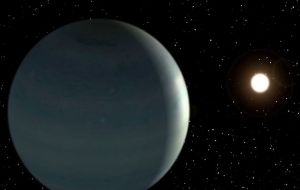MercoPress. South Atlantic News Agency
Astronomers detect outer solar system planet with “moderate” temperatures
 Corot-9b is far cooler than other “exoplanets” discovered to date
Corot-9b is far cooler than other “exoplanets” discovered to date European astronomers have found a planet outside our solar system with a relatively moderate temperature, far cooler than other “exoplanets” discovered to date. The planet Corot-9b has an estimated surface temperature between 160 C and -20 C. It has about 80% of the mass of Jupiter and its orbit is similar to that of Mercury.
“Corot-9b is the first exoplanet that really does resemble planets in our solar system,” Hans Deeg, of the Instituto de Astrofísica de Canarias in Spain, said in a statement.
Corot-9b orbits a star 1,500 light years away in the constellation Serpens, the snake.
“Like our own giant planets, Jupiter and Saturn, the planet is mostly made of hydrogen and helium,” said astronomer Tristan Guillot.
“It may contain up to 20 Earth masses of other elements, including water and rock at high temperatures and pressures,” said Guillot.
The planet passes in front of its host star every 95 days. For the eight hours that it sits between its star and the Earth, astronomers can gather information about the planet based on how it blocks the star's light.
The astronomers' estimate of the planet's surface temperature — between a frosty –20 C and a boiling 160 C — is so wide because it depends on whether the planet has a cloud layer that reflects light and heat back into space.
Their research on the newly discovered planet appears this week in the journal Nature.
“Our analysis has provided more information on Corot-9b than for other exoplanets of the same type,” said study co-author Didier Queloz.
“It may open up a new field of research to understand the atmospheres of moderate- and low-temperature planets, and in particular a completely new window in our understanding of low-temperature chemistry”.
The planet was found in the summer of 2008 using the Corot satellite, operated by the French space agency CNES. The planet's mass and composition were determined by the HARPS instrument attached to the 3.6-metre telescope at La Silla in Chile, operated by the European Southern Observatory.
The satellite also found the planet Corot-7b, a rocky “super-Earth” about 500 light-years away.




Top Comments
Disclaimer & comment rulesCommenting for this story is now closed.
If you have a Facebook account, become a fan and comment on our Facebook Page!